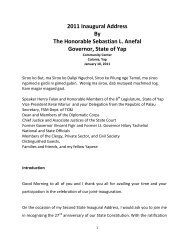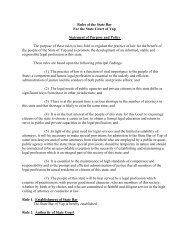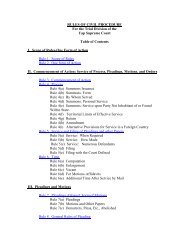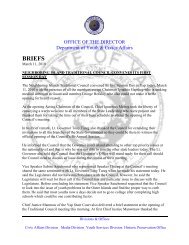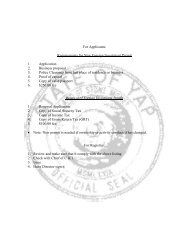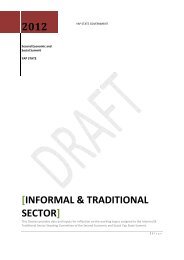CORRIGENDUM No. 2 - Yap State Government
CORRIGENDUM No. 2 - Yap State Government
CORRIGENDUM No. 2 - Yap State Government
Create successful ePaper yourself
Turn your PDF publications into a flip-book with our unique Google optimized e-Paper software.
GENERAL<br />
The design of any off-grid system should consider, other than the electrical load, a number of criteria such as:<br />
o Budget<br />
o Acceptable genset runtime<br />
o Power quality<br />
o <strong>No</strong>ise levels<br />
o Environmental impact<br />
o Site accessibility<br />
o Aesthetics<br />
o Level of automation<br />
<strong>No</strong>te: This guidelines are based on d.c. bus systems and do not include the new a.c. bus hybrid systems currently available. Guidelines dedicated to<br />
hybrid Systems will be developed.<br />
ENERGY SOURCE MATCHING<br />
Heating and lighting should be supplied from the most appropriate source. For example -<br />
o cooking - gas or wood burning stove<br />
o water heating - solar water heating with gas or wood backup<br />
o Lighting - electrical lighting most often used but natural light ( daylighting ) should be considered.<br />
ENERGY EFFICIENCY<br />
All appliances should be chosen for the lowest possible energy consumption for each desired outcome, such<br />
as<br />
o High efficiency lighting<br />
o Energy efficient refrigeration<br />
STANDARDS for DESIGN<br />
System designs should follow any standards that are typically applied in the country or region where the solar<br />
installation will occur. The following lists the relevant standards in Australia, New Zealand and USA They are<br />
listed because some Pacific island countries and territories do follow those standards. These standards are<br />
often updated and amended so the latest version should always be applied.<br />
In Australia and New Zealand the main standards required include:<br />
o AS/NZS3000 Wiring Rules<br />
o AS/NZS4509 Stand-alone power systems<br />
o AS 4086.2 Secondary batteries for stand-alone power supplies<br />
o AS/NZS5033 PV Array<br />
o AS 3010.1 Electrical Installations - Supply Generating set<br />
o AS 1768 Lightning Protection<br />
o AS 3595 Energy management programs<br />
o AS 1359.51 <strong>No</strong>ise level limits<br />
In USA PV systems must be in accordance with the following codes and standards:<br />
o Electrical Codes-National Electrical Code Article 690:Solar Photovoltaic Systems and NFPA 70<br />
Uniform Solar Energy Code<br />
o Building Codes- ICC, ASCE 7<br />
o<br />
o<br />
UL Standard 1701: Flat Plat Photovoltaic Modules and Panels<br />
UL Standard 1741: Standard for Inverter, converters, Controllers and Interconnection System<br />
Equipment for use with Distributed Energy Resources<br />
Issue 1 September 2012 Page 1



